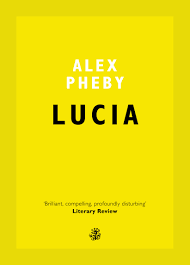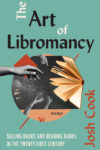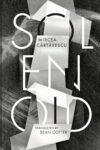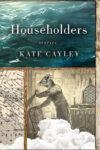
[Biblioasis; 2021]
Every Bloomsday, June 16, James Joyce aficionados read lines of Ulysses and Finnegans Wake aloud at the graveside of his daughter Lucia, who lies buried in Kingsthorpe Cemetery in Northampton, England, where she had spent the last thirty-odd years of her life in a psychiatric hospital. She was multilingual — moving with her family across Europe, from one school to another — and a talented artist who could draw and dance; she studied with some of the most radical dancers and collectives of the bohemian avant-garde scene of the 1920s. Her romantic life was disastrous. She was emotionally troubled, ultimately diagnosed with schizophrenia. She was institutionalized in three clinics throughout her life, often left in isolation and given shots of sea water and animal serum. Lucia danced as a tin soldier for Jean Renoir’s film production of The Little Match Girl in the late 20s, but her scene was cut. She made illustrations for her father’s collection Pomes Penyeach, but the publishers lost them. Biographer Richard Ellmann notably records only the most dismissive remarks about Lucia, said by friends of the Joyces, in his famous biography on her father. Lucia’s creative voice was silenced, her own life misunderstood and reputation warped. And to cap it off, her nephew, Stephen Joyce, known to be litigious and highly protective of his family’s privacy, burned up the correspondence and photos she had left behind, erasing an archive.
It’s easy to understand why a literary mystique has developed around Lucia Joyce. The injustices done to her have even fueled a romantic drive to restore the truth of her life, if only through speculation. Carol Loeb Schloss published a book of Lucia’s life in 2003, but the rhetoric of her prose (a reviewer for the Times called it “fervid glop”) took the project out of the field of biography and into speculation, even wish-fulfilment, so that Lucia’s madness formed a deeply creative, quasi-erotic channeling with her father’s efforts in composing the Wake. There is only so much a writer can factually report in a responsible way, without resorting to the sensory descriptions, minute significant details, and crisp dialog that are the fiction writer’s bread and butter. While the lore generated around Lucia leads to these problems of art and ethics, the ultimately noble project is to restore the life of a deeply wronged woman; as Alex Pheby writes in his book, “there’s a story here, but no one to tell it.” Still, the question remains, is it possible to do right by Lucia by constructing the image we desire of her? Or is it just as cruel to deny her voice based on the scruples of research? Pheby’s third novel Lucia, joint winner of the Republic of Consciousness Prize in 2019, explores this very problem. An ambitious work, Lucia’s scope ultimately goes beyond Lucia Joyce as character, and the suggestions it makes about her life are profoundly disturbing.
Lucia tells two stories in alternating sections. In the first, an archaeologist and an unnamed colleague discover the burial chamber of Egyptian royalty, but the body, the artwork, all the effects prepared to ensure a safe passage to the realm of the dead, have all been vandalized, seemingly by the deceased’s own family. This allegorical tale, told in small snippets of narration, along with incantations and a description of the ancient Egyptian burial process (along with a set of illustrative hieroglyphs) provides the framework for Lucia’s life.
The biographical chapters, usually headed by a location and date and slightly out of chronological order, give a restricted peephole view into one episode, one locale, one significant person in Lucia’s life at a time — she herself may only appear in a cameo role or circumspect reference. Objects are lovingly wrought in full detail, like a teddy bear, “thin-tufted and long-snouted with eyes like raisins, eyes like pinheads, black and shiny, tacked in twice, holding together the seams of white thread,” but they confront the reader unmoored from a fully established setting.
All of that said, the novel’s form is not overly challenging. Pheby brings a level of polish to his writing that is thorough and consistent. The Egyptology template notwithstanding, the prose is happily grounded in traditional realism; the rare flashes of modernist experiment are much closer to Woolf than to Joyce (a playful use of square brackets late in the book comes to mind). It is not an ostentatious style nor intricate structure that are the sources of Lucia’s difficulty, instead it is the qualities of the novel’s third person narrator.
Many of Lucia’s chapters, using the framework of the Egypt chapters, focus on her Ib (body), her Ba (soul), and her Shuyet shadow. Lucia’s “Shuyet shadow” may refer to her assumed madness but, as the reader comes to realise, there were wounds inflicted before the illness manifested, wounds that undoubtedly created the trauma from which her psychological struggles developed . Pheby describes how Lucia lived in cramped homes, cooped up with her brother Giorgio; early in the book she watches as he tortures her pet rabbit, which he does to scare her into staying silent about the sexual acts he’s committing against her. This is one facet of the horror at the center of Lucia’s story (one that other texts have hinted at), but its speculative nature does not necessarily relieve the reader’s qualms.
If there are those of you reading this who know Giorgio, you might say that this never happened. But how do you know? How does one ever know what it is that occurs outside the range of one’s experience? You may not know that it did happen, but that is not the same as knowing that it did not happen. Perhaps if there were documentary evidence; but who keeps such records? Is it even possible to keep evidence of things that might happen that someone wishes to keep secret?…All things that are possible are, in the absence of facts that have been destroyed that might have proved them incorrect, equally correct.
And what about Lucia’s celebrated father? James Joyce was a supreme achiever of literary art, but he was also a dad, and the father can be an ogre as well as being a guardian. “Under what conditions may James Joyce beat his daughter?” the narrator says with characteristic boldness. He may do so when she is being disobedient, or coming home late. And “if” Lucia were to throw a chair at Nora Barnacle in the middle of one of their rows, the narrator says, “this can really hurt.”
This voice Pheby has constructed, like a lawyer’s speech, with its modal verbs, hypothetical rhetoric, and endless equivocation, is the source of the novel’s challenge. As the passage above suggests, the voice is an upshot of the destruction of Lucia’s life and legacy, the wilful desecration of a princess’s tomb. The voice is contemptuous, self-satisfied with its generic wisdom, sometimes impatient and even nasty toward Lucia herself. “Lucia — you are an audience, and an audience is a wonderful thing, but interchangeable with any other audience.”
What exactly that voice is doing in Pheby’s novel becomes clear as the narration draws more on the medical, scientific, and social knowledge of the day, political economy, for example: “let us instead say that many generations of men have made their living from the creation of, and sale of, physical objects of this or that sort, the value of which is determined by their utility.” These cogent but incorrect thoughts amount to a particular standpoint: the stifling, fastidious, unbearably chauvinistic intellectual climate of a western Europe in decadent decline. The links become explicit once Lucia is institutionalized for good, and these are harrowing chapters.
The standpoint that Pheby renders for us gives context to Lucia’s suffering, and it also deflates her unkind treatment in literature. Now we grasp the paternalistic attitude that distorted Lucia’s image so much in Ellmann’s book. And Beckett’s Syra-Cusa from his novel Dream of Fair to Middling Women, supposedly modeled on Lucia, “her body more perfect than dream creek, amaranth lagoon,” need not be taken so seriously. That same legal fussiness that permeates the work (“Any representations of actual persons are either coincidental, or have been altered for artistic effect”) is also what opens up pre-war Europe as a great gothic manor of repressed horrors. Lucia the madwoman was stowed away, by her family and society at large, in one of its moldering rooms.
Guiding us through the mystery is Pheby’s precise writing, that carefully handles the historical material while also drawing on elements of horror and fairy tales. Even as the novel makes us sit with the frustrations of wanting to see Lucia’s inner life realized, and even if the free indirect discourse that gives rise to “the voice” may not be to every reader’s liking (I confess I only liked it mildly), Lucia makes a new reading of the Joycean lore possible. In that sense Pheby’s novel is part of a larger cultural corrective on Lucia’s behalf. Her story has been represented recently in a graphic novel, a play, and in Alan Moore’s 2016 novel Jerusalem. Texts like Lucia invite us to reconsider Lucia as not simply an ruined and silenced woman, interesting only by virtue of being the daughter of James Joyce, but an artist who could have had an outlet, could have given herself and left us with more. And from there, the whole sequence of European modernism may be re-thought, and women like Lucia Joyce, like Leonora Carrington, like Unica Zürn, written off for so long as mad daughters and muses, may yet become that constellation’s most prominent stars.
Alex Lanz has published stories, essays, and criticism in magazines including Entropy, Shantih, and Empty Mirror. They live in Brooklyn.
This post may contain affiliate links.







